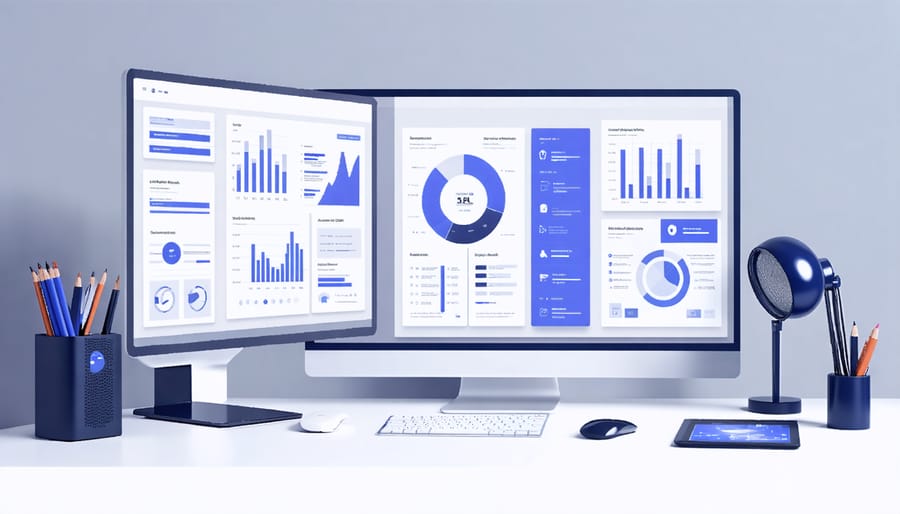AI Content Optimization Makes Your CMS Work Smarter (Not Harder)

AI content optimization revolutionizes how businesses create, manage, and distribute digital content by leveraging artificial intelligence to maximize its impact and reach. Through advanced AI content management systems, organizations can now automatically analyze, enhance, and personalize their content strategy with unprecedented precision.
Think of AI content optimization as your digital marketing team’s intelligent assistant, working 24/7 to ensure every piece of content performs at its peak. It analyzes user behavior, predicts content performance, and makes real-time adjustments to improve engagement, conversion rates, and SEO rankings. From automatically generating SEO-friendly meta descriptions to identifying trending topics within your industry, AI transforms traditional content management into a data-driven, results-oriented process.
For marketing professionals and business owners, this means spending less time on manual optimization tasks and more time developing strategic, creative content that resonates with their target audience. The technology doesn’t just streamline workflows—it provides actionable insights that help create more impactful content while maintaining brand consistency across all channels.

How AI Content Optimization Transforms Your CMS
Real-Time Content Analysis and Enhancement
AI content optimization platforms employ sophisticated algorithms to analyze and enhance content in real-time, providing immediate feedback and suggestions for improvement. These systems evaluate multiple aspects of your content simultaneously, ensuring it meets both user expectations and search engine requirements.
The analysis typically begins with a comprehensive assessment of your content’s readability metrics, including sentence structure, paragraph length, and vocabulary complexity. AI tools can identify areas where text may be too dense or difficult to understand, suggesting alternatives that maintain your message while improving clarity.
From an SEO perspective, the AI continuously monitors keyword usage, distribution, and relevance. It goes beyond simple keyword density checks to evaluate semantic relationships, topic coverage, and content depth. This ensures your content remains naturally optimized for search engines without falling into the trap of keyword stuffing.
The enhancement process also includes real-time recommendations for:
– Header structure and organization
– Content gaps and topic opportunities
– Grammar and style consistency
– Engagement potential
– Mobile responsiveness
– Meta description optimization
What sets AI-powered analysis apart is its ability to learn from user engagement data and adapt recommendations accordingly. The system can identify patterns in successful content and apply these insights to new pieces, creating a continuous improvement cycle.
For business owners and marketing professionals, this means spending less time on manual content audits and more time creating value for their audience. The AI’s ability to provide instant feedback helps maintain consistent quality across all content pieces while reducing the resource investment typically required for thorough content optimization.
Automated Content Personalization
In today’s digital landscape, AI-driven content personalization has become a game-changer for businesses seeking to deliver more relevant and engaging experiences to their audience. By leveraging sophisticated algorithms and machine learning capabilities, AI can analyze user behavior, preferences, and interaction patterns to automatically tailor content for different segments of your audience.
This personalization happens in real-time, adjusting everything from headlines and body copy to calls-to-action based on factors such as user location, device type, browsing history, and previous interactions with your content. For example, a returning visitor might see different product recommendations than a first-time visitor, while a mobile user could receive content optimized for smaller screens.
The power of automated personalization lies in its ability to scale. While manual segmentation and targeting can be time-consuming and resource-intensive, AI systems can instantly process vast amounts of data to create personalized experiences for thousands of users simultaneously. This includes:
– Dynamic content blocks that adjust based on user preferences
– Personalized product recommendations
– Custom email content tailored to individual engagement patterns
– Adaptive landing pages that reflect user interests
– Smart content scheduling based on optimal viewing times
The result is higher engagement rates, improved conversion rates, and better ROI on content marketing efforts. Businesses implementing AI personalization typically see a 20-30% increase in conversion rates and significant improvements in customer satisfaction scores.
Remember that effective personalization requires clean data and clear business objectives. Start with basic segmentation and gradually increase complexity as you gather more user insights and feedback.

Key Features of AI-Optimized CMS Solutions
Smart Content Scheduling and Distribution
AI-powered content scheduling and distribution takes the guesswork out of when and where to publish your content for maximum impact. By analyzing historical engagement data, user behavior patterns, and real-time audience activity, AI systems can determine the optimal posting times that will generate the highest visibility and engagement for your content.
These intelligent systems track metrics such as click-through rates, social media interactions, and conversion data across different time zones and platforms to identify when your target audience is most active and receptive. The AI then creates automated publishing schedules that align with these peak engagement periods, ensuring your content reaches the right people at the right time.
Beyond timing, AI also optimizes your distribution strategy by analyzing which channels perform best for different types of content. For example, it might determine that your how-to articles perform better on LinkedIn during business hours, while visual content gets more traction on Instagram in the evenings. This data-driven approach allows for smart, automated cross-channel distribution that maximizes your content’s reach and impact.
The system continuously learns from performance data, adjusting schedules and distribution patterns based on changing audience behaviors and engagement trends. This dynamic optimization ensures your content strategy remains effective and responsive to audience preferences over time.
SEO Enhancement and Performance Tracking
Modern AI-driven SEO optimization tools have revolutionized how businesses approach content performance tracking and enhancement. These intelligent systems continuously monitor key metrics such as keyword rankings, organic traffic, and user engagement patterns to provide actionable insights for content improvement.
AI algorithms analyze vast amounts of data to identify trending topics, search intent patterns, and content gaps in real-time. This enables businesses to make data-driven decisions about content updates and optimization strategies. The technology automatically suggests keyword opportunities, recommends content structure improvements, and highlights areas where content may need refreshing to maintain relevance.
Performance tracking through AI goes beyond traditional analytics by offering predictive insights. These systems can forecast content performance trends, helping businesses stay ahead of market changes and competitor movements. They also provide automated recommendations for meta descriptions, title tags, and header optimizations that align with current SEO best practices.
What sets AI-powered tracking apart is its ability to correlate multiple data points simultaneously. For instance, it can identify relationships between page load speed, user behavior, and conversion rates, providing a comprehensive view of content performance. This holistic approach helps businesses understand not just what’s happening with their content, but why it’s happening and how to improve it.
Most importantly, these tools provide clear, actionable reports that help stakeholders make informed decisions about their content strategy without getting lost in technical details.

Implementation Strategies for Business Success
Integration with Existing Systems
Integrating AI content optimization tools into your existing workflow doesn’t have to be disruptive. Start by auditing your current content management system (CMS) and identifying integration points. Most modern AI optimization platforms offer API connections or direct plugins for popular CMS platforms like WordPress, Drupal, and Shopify.
Begin with a pilot program focusing on a specific content type or channel. This could be your blog posts, product descriptions, or social media content. Configure your AI tools to analyze existing content first, establishing baseline metrics for improvement.
Set up automated workflows where possible. For example, configure your system to automatically run AI optimization checks before content publication. Create clear guidelines for your team about when and how to use AI tools during the content creation process.
Establish a feedback loop between your content team and AI systems. Monitor performance metrics and adjust optimization parameters based on real results. Regular training sessions for team members ensure everyone understands how to leverage the AI tools effectively.
Remember to maintain your brand voice by calibrating AI suggestions against your style guide and brand requirements. This ensures optimization enhances rather than overwrites your unique brand identity.
Measuring ROI and Performance Metrics
To effectively gauge the success of your AI content optimization efforts, tracking key performance indicators (KPIs) is essential. When measuring AI optimization ROI, focus on metrics that directly impact your business objectives.
Start by monitoring organic traffic growth, page rankings, and click-through rates (CTRs) from search engines. These metrics indicate how well your optimized content performs in search results. Track engagement metrics like time on page, bounce rate, and social shares to understand how users interact with your content.
For conversion-focused optimization, measure lead generation rates, form submissions, and actual sales attributed to optimized content. Compare these metrics before and after implementing AI optimization to quantify the impact.
Tools like Google Analytics, Search Console, and your CMS’s built-in analytics can help track these metrics. Set up regular reporting intervals (weekly or monthly) to monitor trends and adjust your optimization strategy accordingly. Remember to factor in the cost of AI tools against revenue increases to calculate your true return on investment.
Focus on metrics that align with your specific business goals and maintain consistent tracking methods for accurate performance assessment.
AI content optimization is revolutionizing how businesses manage and deliver their digital content. By leveraging machine learning and natural language processing, organizations can now streamline their content workflows, improve user engagement, and drive better results across their digital platforms. The future of AI in content management systems looks increasingly promising, with emerging technologies enabling even more sophisticated personalization and automation capabilities.
As businesses continue to compete in the digital landscape, AI content optimization will become not just a luxury but a necessity. Organizations that embrace these tools early will gain a significant competitive advantage, benefiting from improved efficiency, reduced costs, and enhanced content performance. With AI technology evolving rapidly, we can expect to see even more innovative features that will further transform content management and marketing strategies, making it easier than ever for businesses to create, optimize, and deliver compelling content that resonates with their target audience.
Leave a Reply